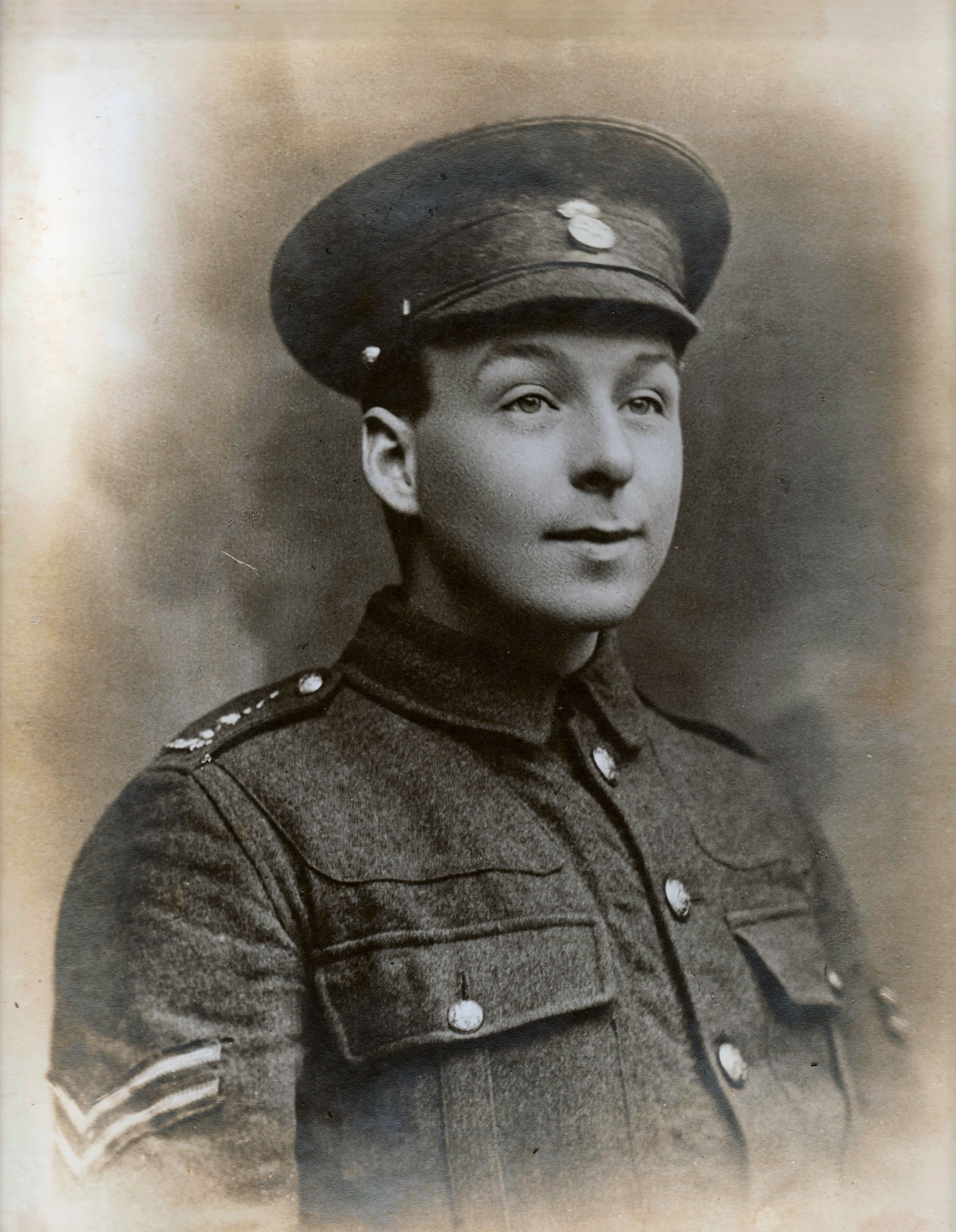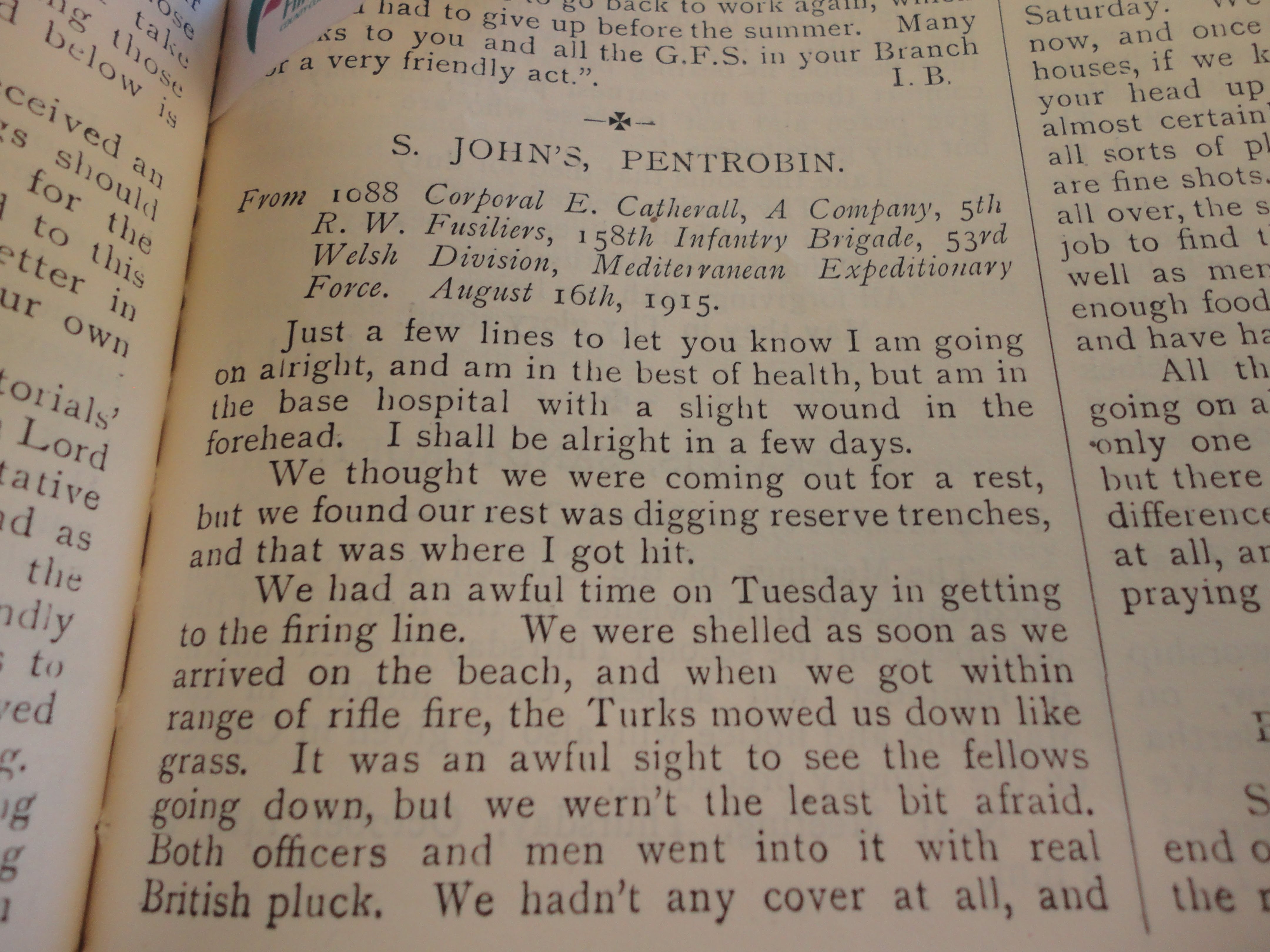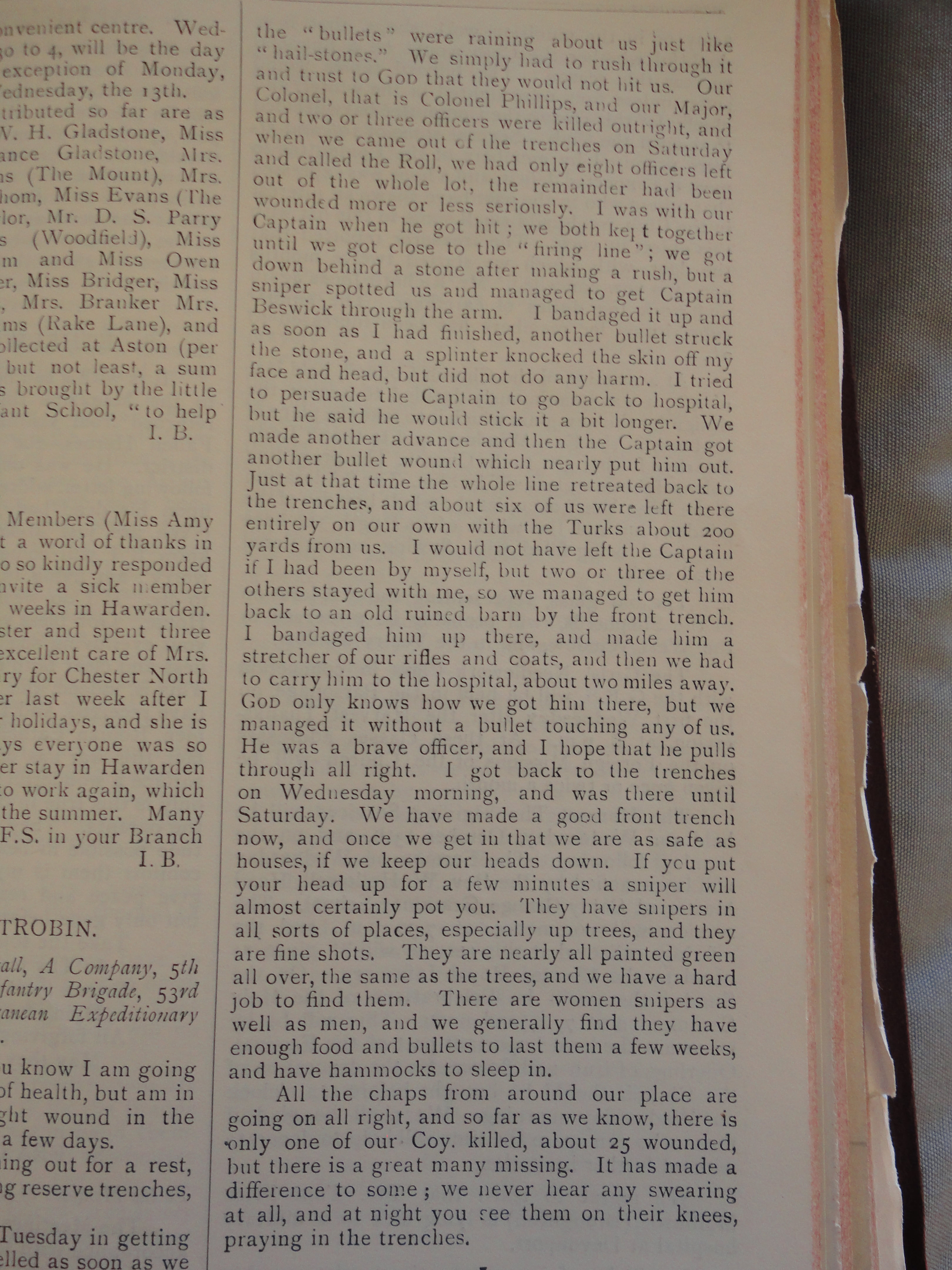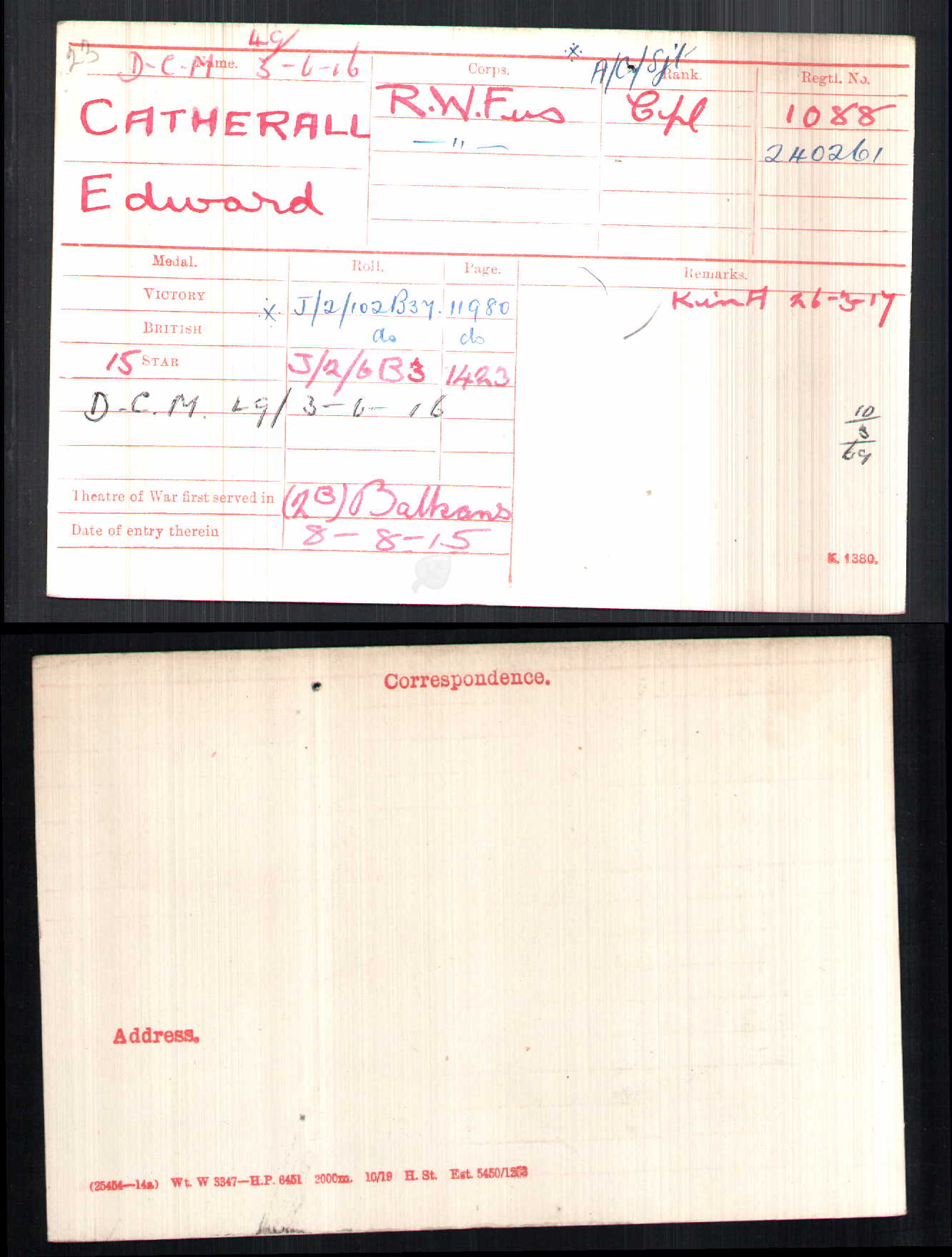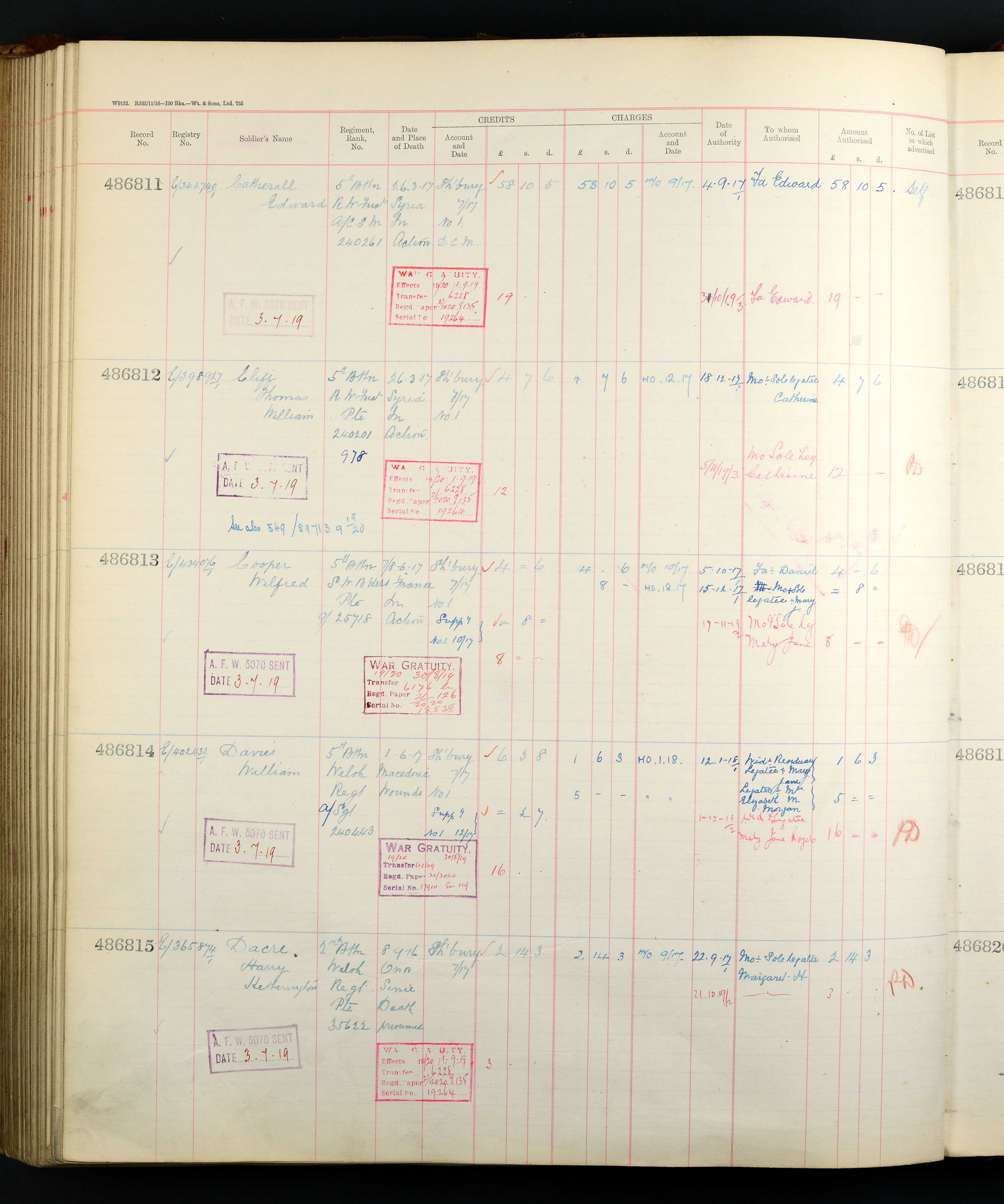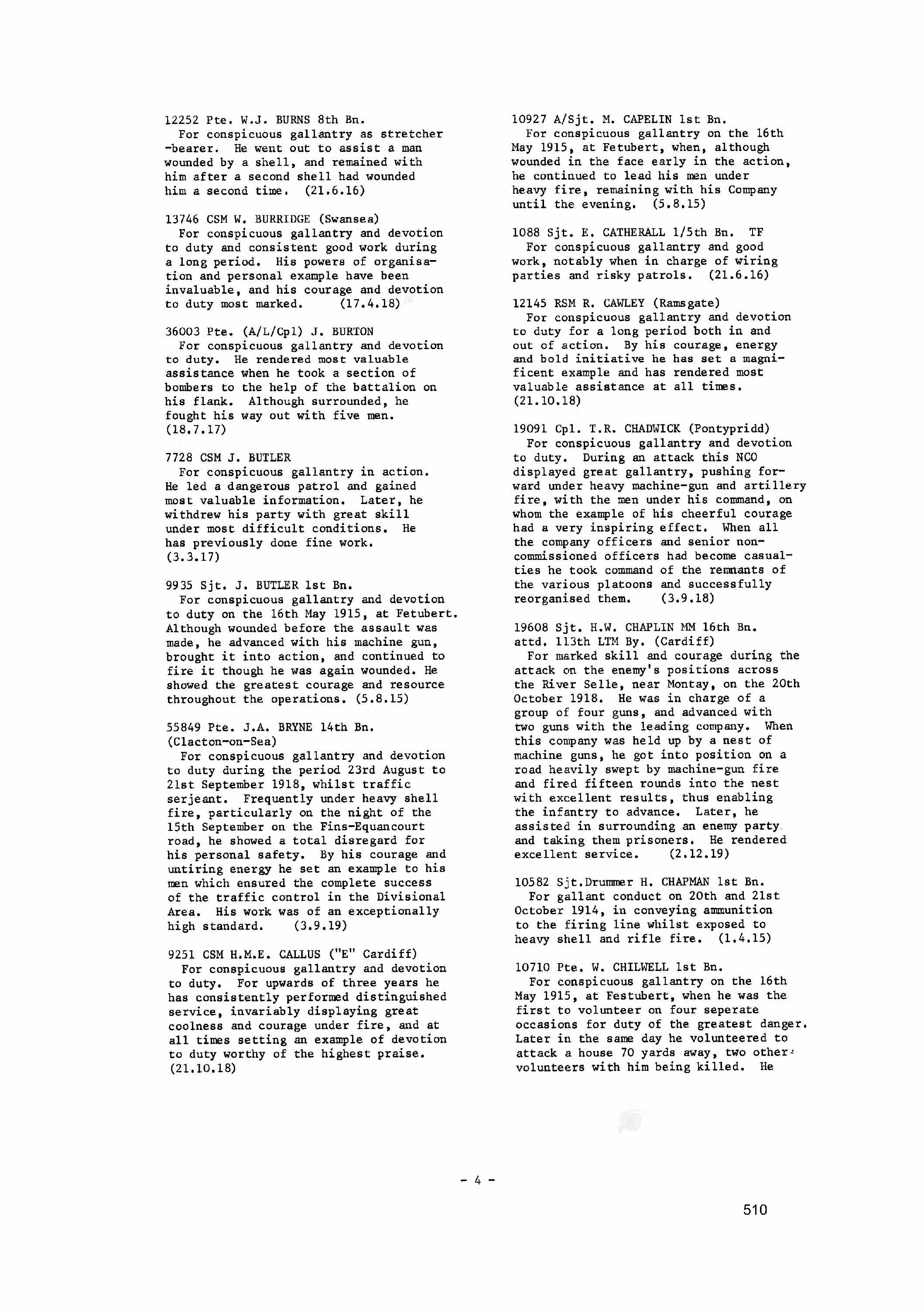Edward Catherall’s birth was registered in Hawarden in 1894 (HAW/41/6) and he first first appeared on a census in 1901 when he was recorded as living at Stoney Hill, Bannel & Pentrobin, Hawarden, Flintshire. Edward’s father was 36 and a Coal Miner who had been born in Hawarden. Edward’s mother Elizabeth Ann, 32 had been born in Chester. Their listed children were Bertha 10 and Harriet 8 (both had been born in Lancashire). Edward was 6, Hannah 4, and Samuel 2. The three youngest had been born in Hawarden. Living with the family was Edward (Snr’s) mother, a 72 year old Widow.
I have now been contacted by his nephew Anthony Edward Catherall who tells me that Edward was born on the 24th October 1894, many thanks to him for this information.
By the 1911 census they were still at Stoney Hill. Edward 46, was listed as a Coal Miner (Hewer). His wife of 21 years, Elizabeth was 42. Elizabeth had given birth to 6 children, none of whom had died. Edward was 16 and a Coal Miner (Filler). Samuel 12 and Stanley 9 were both at School.
UK Soldiers who Died in The Great War 1914 -19, accessible on www.ancestry.co.uk confirms the regimental details above and adds that he enlisted in Hawarden.
Edward Catherall’s Medal Card also accessible on ‘ancestry’ confirms all his medal details. This source gives us his former regimental number and it tells us that his first theatre of war was The Balkans and he entered it on the 8th of August 1915.
Edward’s Army Service Records have survived and are accessible on www.ancestry.co.uk They tell us that he enlisted in 1912 when he was 18 years of age. He stated his trade was a Plate Layer and that he had been employed by the G.C. Railway Coy. He gave his family home address of Stoney Hill, Pentrobin. Inspector T. Jones from Wrexham Exchange Station was asked to be a referee and he stated that Edward had worked at the Exchange Station, Wrexham as a Labourer for 6 months.
Edward was described as 5 feet 7 inches tall, fair complexion, grey eyes and light hair. His chest measured 38 inches with a range of expansion of 2 inches. His vision and physical development were deemed to be good and he was considered to be fit for the army. His religion was C of E.
Edward underwent preliminary training from 1st November 1912 until 26th July 1913. He underwent ‘annual training’ at Rhyl in 1913. It wasn’t until the 5th August 1914 that he was finally embodied into the regiment and was appointed Lance Corporal. He must have been a model soldier as his promotions came along steadily. Corporal, Acting Sergeant, and Company Sergeant Major.
His records show that he sailed for Gallipoli on HMT Caledonia on the 14th July 1915. He was admitted to hospital on the 15th August that year with a gunshot wound to his left eye. He rejoined his battalion a week later. Throughout the last half of 1915 he had recurring bouts of dysentry and was hospitalised a number of times. After a short period in a Rest Camp in December 1915, he was back with the Battalion in January 1916.
I found this letter from Edward in the Hawarden Parish Magazine under St. John’s, Pentrobin-
Letter from 1088 Corporal E. Catherall, A Company, 5th R.W. Fusiliers, 158th Infantry Brigade, 53rd Welsh Division, Mediterranean Expeditionary Force. August 10th, 1915.
Part of the letter in the Hawarden Parish Magazine. (If you would like the rest I can send it to you, it is too large to go in here, please contact the website)
“Just a few lines to let you know I am going on alright, and am in the best of health, but am in the base hospital with a slight wound in the forehead. I shall be alright in a few days.
We thought we were coming out for a rest, but we found our rest was digging reserve trenches and that was where I got hit.
We had an awful time on Tuesday in getting to the firing line. We were shelled as soon as we arrived on beach, and when we got within range of rifle fire, the Turks mowed us down like grass. It was an awful sight to see to see the fellows going down, but we weren’t the least bit afraid.
Both officers and men went into it with real British pluck. We hadn’t any cover at all, and the “bullets” were raining about us just like “hail-stones.” We simply had to rush through it and trust to God that they would not hit us. Our Colonel, that is Colonel Phillips, and our Major, and two or three officers were killed outright, and when we came out of the trenches on Saturday and called the roll, we had only eight officers left out of the whole lot, remainder had been wounded more or seriously. I was with our Captain when he got hit; we both kept together until we got close to “firing line”; we got down behind a stone after making a rush, but a sniper spotted us and managed to get Captain BESWICK through the arm. I bandaged it up and as soon as I had finished, another bullet struck the stone, and a splinter knocked the skin off my face and head, but did not do any harm. I tried to persuade the Captain to go back to hospital, but he said he would stick it a bit longer. We made another advance and then the Captain got another bullet wound which nearly put him out.
Just at the time the whole line retreated back to the trenches, and about six of us were left there entirely on our own with the Turks about 200 yards from us. I would not have left the Captain if I had been by myself, but two or three of the others stayed with us with me, so we managed to get him back to an old ruined barn by the front trench.
I bandaged him up there, and made him a stretcher of our rifles and coats, and then we had to carry him to the hospital 2 miles away. God only knows how we got him there, but we managed it without a bullet touching any of us. He was a brave Officer and I hope he pulls through all right.
I got back to the trenches on Wednesday morning, and was there until Saturday.
We have made a good front trench now, and once we get in that we are as safe as houses, if we keep our heads down. If you put your head up for a few minutes a sniper will almost certainly pot you. They have snipers in all sorts of places, especially up tree, and they are fine shots. They are nearly all painted green all over, the same as the trees, and we have a hard job to find them. There are women snipers as well as men, and we generally find they have enough food and bullets to last them a few weeks, and have hammocks to sleep in.
All the chaps from around our place are going on all right, and so far as we know, there is only one of our Coy. killed, about 25 wounded, but there are a great many missing. It has made a difference to some; we never hear any swearing at all, and at night you see them on their knees, praying in the trenches.” (Letter reproduced below the map)
This remarkable soldier was recognized for his outstanding contribution. He was ‘mentioned in despatches in ‘The London Gazette’ more than once.
Mentioned in General Sir Charles Monroe’s Gazette Despatch for ‘distinguished and gallant services rendered during his command of the MEF’.
Edward Catherall ‘awarded DCM for conspicuous gallantry and good work notably when in charge of wiring parties and risky patrols’.
Having been Acting Company Sgt Major since the 13th January 1917 he was appointed to the actual position on the 4th March 1917 and he was killed in action on the 26th March 1917.
His army record contains a list of close family members which was compiled in 1921
Father Edward Catherall 55, Stoney Hill, Hawarden
Mother Elizabeth Ann Catherall, 51, address as above.
Brothers (Full Blood) Samuel Catherall 20 Stanley Catherall 17
Sisters (Full Blood) Bertha Catherall age 29, Harriet Catherall 27 and Mrs. H. Seager age 22, address 18 Stafford Road, Kilburn, London.
The form was signed by Edward Catherall, Father, Stoney Hill, Hawarden, Nr. Chester. Witnessed by H.J. Rees Qualification:- Clerk of Holy Orders, address:- St. John’s Parsonage, Pentrobin, Mold.
There was correspondence in the records between the army and Edward’s father regarding the receipt of personal property,medals, plaque, scroll and citation and certificate.
There is an index card for Edward in the Flintshire Roll of Honour at the County Record Office in Hawarden. There is a slight mystery as his period of service does not tally with the years of service in his Army Service Records. It states his service was 2 years 7 month. On his Army records his Service was 4 years 146 days. (Perhaps the smaller figure represented his time from when he was actually ’embodied’ into the Regiment).
In the County Herald dated 27th April 1917 a List of Casualties was published and Edward was among the men who were named as having been killed– Royal Welsh Fusiliers – Catherall – 1088 Act./Co. Sgt. Major – E (Hawarden)
Edward Catherall n the UK, Army Registers of Soldiers’ Effects, 1901-1929 – Sole Legatee was his father Edward who received £58 10s 5d on the 4th September 1917 (Self) and his War Gratuity of £19 on the 31st October 1919.
Edward’s father, Edward Catherall Snr was also in the war but survived. There is an index card for him in the Flintshire Roll of Honour at The County Record Office in Hawarden. (Flintshire WW1 Index Card Penymynydd L5 Catherall, Edward, Stoney Hill, Penymynydd). It states his Regimental Number as 30561. Unit 323 Pro.? Coy. R.D.C. (Royal Defence Corps). He served for 1 year and 296 days. (The Royal Defence Corps, Protection Company,was used for duties such as providing guards for premises, bridges, factories, ports, POW camps and other important sites They were for home service in the UK only and mostly contained men who were too old or medically unfit to serve overseas).
